Effects of Dispersal for a Logistic Growth Population in Random Environments
Abstract
We study a stochastic logistic model with diffusion between two patches in this paper. Using the definition of stationary distribution, we discuss the effect of dispersal in detail. If the species are able to have nontrivial stationary distributions when the patches are isolated, then they continue to do so for small diffusion rates. In addition, we use some examples and numerical experiments to reflect that diffusions are capable of both stabilizing and destabilizing a given ecosystem.
1. Introduction
Dispersal is a ubiquitous phenomenon in the natural world. This phenomenon plays a very important role in understanding the ecological and evolutionary dynamics of populations. The theoretical studies of spatial distributions can be traced back as far as Skellam [1]. Then many scholars have focused on the effects of spatial factors which play a crucial role in the study of stability. Some mathematical models dealt with a single population dispersing among patches (see [2–9] and references cited therein). The others dealt with competition or predator-prey interactions in patchy environments (see [10–16] and references cited therein). These models centered round local and global stability of equilibrium points, persistence, and extinction of populations.
Through the studies for the diffusion systems and the corresponding ones without diffusion, many authors have discussed the relationship between the existence of the equilibriums and their stability. Levin [10] showed that two unstable competitive patches can be stabilized by diffusion; Levin [11] also showed that diffusion can destabilize a stable system by using a prey-predator model; Allen [4] proved that a single species diffusion system remains weakly persistent if the strength of diffusion is small enough; Beretta and Takeuchi [5, 6] showed that small diffusion cannot change the global stability of the model. Takeuchi also proved that diffusion among patches will not destabilize single-population dynamics [9].
However, the most natural phenomena do not follow strictly deterministic laws, but rather oscillate randomly about some averages. That is to say populations in the real word are inevitably affected by various environmental noises which is an important phenomenon in ecosystems [17–19]. So we will consider a stochastic diffusion system which is composed of two patches and connected by diffusion. Then we want to know ‘‘how are the effects of dispersal under random environments?” According to the author′s best knowledge, there are few results dealing with this problem, and stabilizing and/or destabilizing effects of dispersal remain largely unknown due to difficulties involved by random disturbances. Generally speaking, there does not have time independent equilibrium point for a stochastic system. Hence we will investigate the effects of dispersal by the concept of stationary distribution (some analogue which plays the role of the deterministic equilibrium point and reflects the stability to some extent). In this paper, we will show that diffusion cannot change the existence of stable stationary distribution for the stochastic model if the strength of diffusion is small enough. Moreover, small diffusion rates have some stabilizing effects, and large diffusion rates have some destabilizing effects on the stochastic model. That is, diffusions are capable of both stabilizing and destabilizing a given ecosystem.
2. Formulation of the Mathematical Model
3. Existence and Uniqueness of the Positive Solution for System (4)
Theorem 1. For any initial value , there is a unique solution (x1(t), x2(t)) to system (4) on t ≥ 0, and the solution will remain in with probability 1.
Proof. Our proof is motivated by the works of Mao et al. [22]. All the coefficients in system (4) are locally Lipschitz continuous; then for any given initial value , there is a unique maximal local solution (x1(t), x2(t)) on t ∈ [0, τe], where τe is an explosion time (see e.g. [23, 24]). In order to show this solution is global, we only need to prove τe = ∞. Let k0 > 0 be so large that xi(0), i = 1,2 lying within the interval [1/k0, k0]. For each integer k > k0, define stopping times as follows:
Theorem 1 shows that the solution of system (4) will remain in the positive cone . This nice positive invariant property provides us with a great opportunity to construct different types of the Lyapunov functions to discuss the stationary distribution for system (4) in in more detail.
4. Stationary Distribution for System (4)
Assumption B. There exists a bounded domain with regular boundary, having the following properties.
- (B1)
In the domain U and some neighborhood thereof, the smallest eigenvalue of the diffusion matrix A(x) is bounded away from zero.
- (B2)
for all n, where Kn is a family of countable compact subsets such that ; Exτ is the mean time τ at which a path issuing from x reaches the set Kn.
Lemma 2 (see [25].)If (B) holds, then the Markov process X(t) = (x1, x2) has a stable stationary distribution μ(·) confined on .
The deterministic system (2) has two equilibrium points, namely, E0(0,0) and . Takeuchi [9] has proved that this single species diffusion model has a positive and globally stable equilibrium point for any diffusion rate; the results obtained in his paper show that no diffusion rate; can change the global stability of the deterministic model.
Theorem 3. Let σ1 > 0, σ2 > 0 such that
Proof. Define ,
Lemma 4 (see [32], Corollary 1.)Equation dx(t) = x(t)(r − kx(t))dt + αx(t)dB(t) has a nontrivial stationary distribution if and only if α2 < 2r.
Remark 5. Suppose there is no diffusion; that is, ε12 = ε21 = 0. Then condition (21) is always satisfied, and the corresponding equations,
Remark 6. Suppose condition (24) is satisfied. Then the species has a nontrivial stationary distribution in all patches if the patches are isolated; that is, the diffusion among patches is neglected, and the species is confined to each patch. Condition (21) can be satisfied when we choose ε12, ε21 sufficiently small. Then we have a conclusion that diffusion cannot change the existence of stable stationary distribution for stochastic system if the strength of diffusion rate is small enough.
Remark 7. An immediate consequence of condition (22) is that environmental noises are against the stationary distribution for stochastic system. If , ; that is, only species in the 2nd patch have a nontrivial stationary distribution when there is no diffusion. But we can choose ε21 sufficiently small such that conditions in Theorem 3 are satisfied, and there exists a stationary distribution for (x1(t), x2(t)). This implies small diffusion rate has some stabilizing effects on stochastic system. However, if we choose ε21 sufficiently large, then the conditions of Theorem 3 are destroyed which implies large diffusion rate also has some destabilizing effects on stochastic models.
5. Examples and Numerical Simulation
It is very difficult to choose parameters in the system from realistic estimation. The estimation of the parameters can be derived by some statistical methods and filtering theory which are linked to statistical problems and filtering problems. Therefore, we will only use some hypothetical parameters to verify the theoretical effects in this section.
Example 8. For system (38), we let r1 = 0.9, k1 = 1.2, , r2 = 1.1, k2 = 0.2, and σ2 = 0.8. Note that and ; so for system (38), species in the 1st patch has a Dirac delta distribution with mass concentrated in 0, and species in the 2nd patch has a nontrivial distribution. (see literature [32].) Numerical simulations of (38) are showed in Figures 1(a) and 1(b).
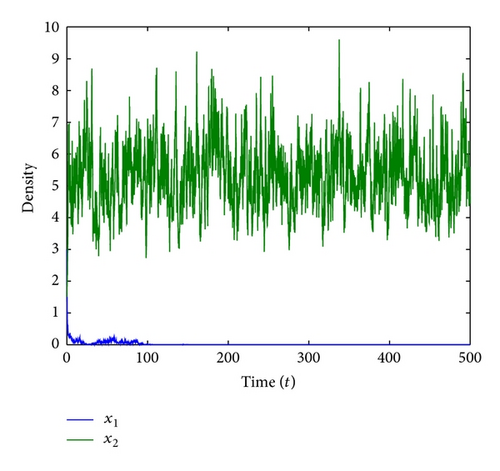
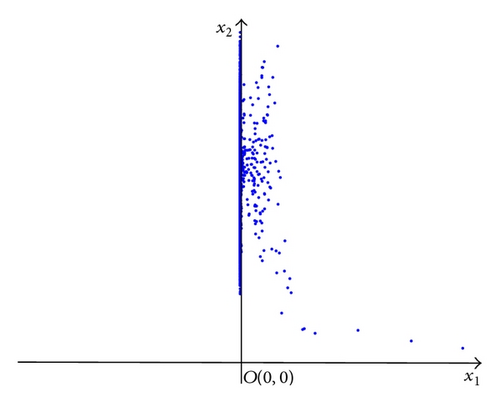
Example 9. For system (4), we let r1 = 0.9, k1 = 1.2, ε12 = 0.1, , r2 = 1.1, k2 = 0.2, ε21 = 0.4, and σ2 = 0.8. Its corresponding deterministic system (2) has a globally asymptotically stable equilibrium point E*(x*, y*) = (1,4). We also have
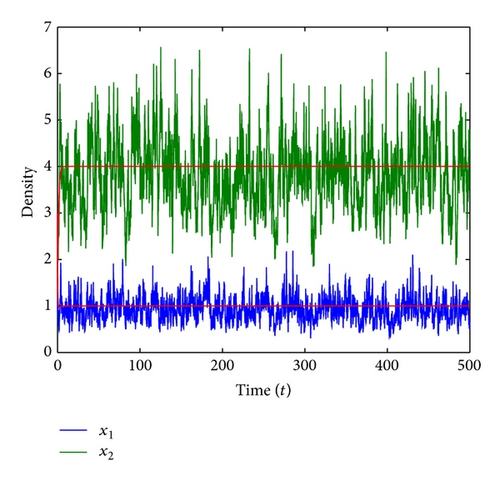
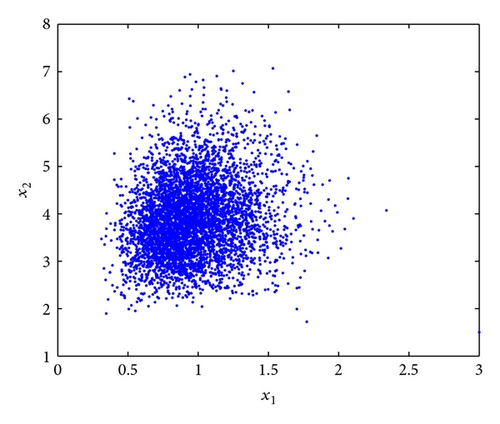
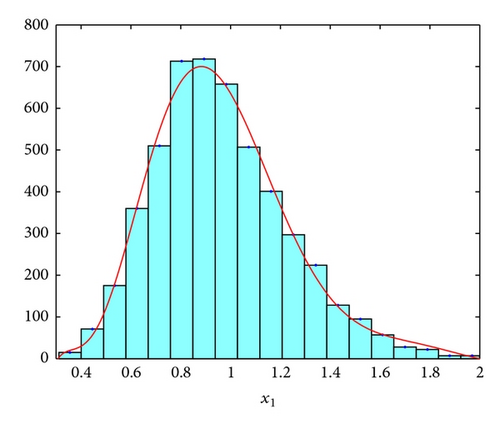
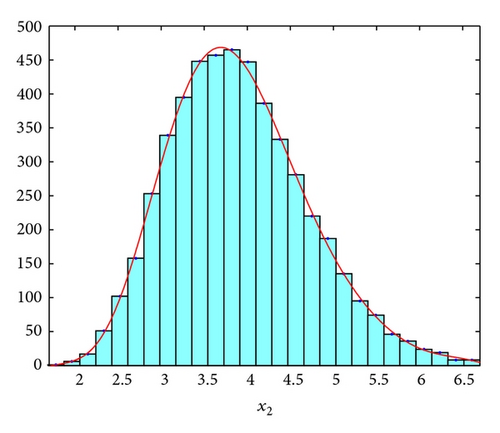
Example 10. For system (4), we let r1 = 0.9, k1 = 1.2, ε12 = 0.1, , r2 = 1.1, k2 = 0.2, ε21 = 5, and σ2 = 0.8. It is clear that conditions of Theorem 3 are destroyed and numerical simulations of this example showed in Figures 3(a) and 3(b). The destabilizing effect of large diffusion rate can be seen clearly from this example.
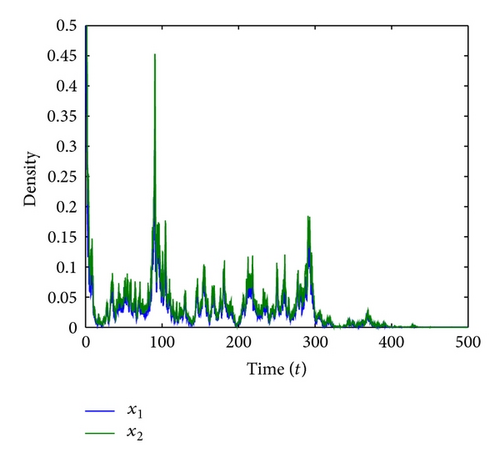
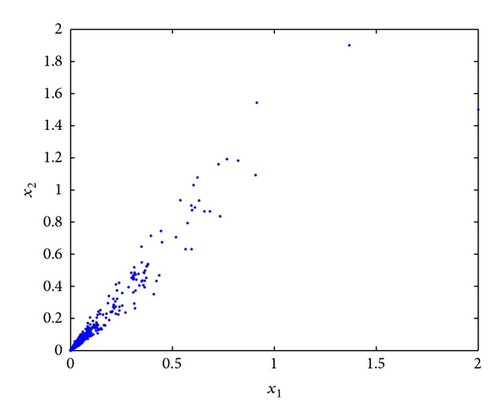
6. Concluding Remarks
The main objective of this paper is to study the effects of dispersal on stationary distribution for a stochastic logistic diffusion system. We show that the dispersal stabilizes the system when the dispersal rate is small, and destabilizes the system, when the dispersal rate is large. Our results show that small dispersal rate cannot change the existence of stationary distribution for the stochastic model such as it cannot change the global stability of the deterministic model. Though diffusions have stabilizing effects, our examples show that dispersal may also have the side effects which result in destabilization. This suggests that dispersal among patches should be regulated. Their ecological implications are that neither no diffusion nor unlimited diffusion may serve the interest of stabilizing the given ecosystem in random environments! This observation may be useful in planning and controlling of ecosystems.
Acknowledgments
The authors would like to thank the editor and the referees for their suggestions which improved the presentation of this paper. This paper was partially supported by Grants from the National Natural Science Foundation of China (no. 11171081), (no. 11171056), (no. 11126219), (no. 11001032), and (no. 11101183), Shandong Provincial Natural Science Foundation of China (Grant no. ZR2011AM004), and Natural Scientific Research Innovation Foundation in Harbin Institute of Technology (HIT.NSRIF.2011094).




